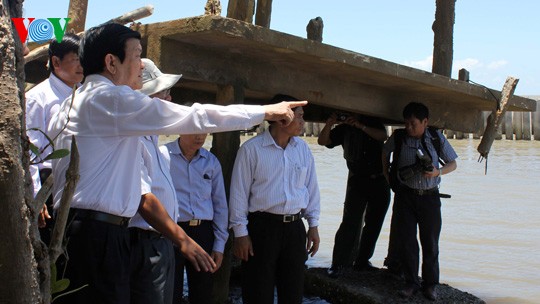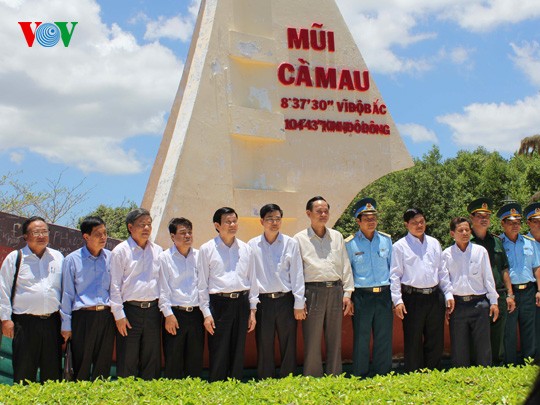(VOVworld) President Truong Tan Sang and a delegation of central agency leaders have recently made a fact-finding tour of Mekong delta’s sea dyke system. Sang said sea dyke development is a follow-up task to building a protective dyke system that can resist climate change and ensure food security and economic growth in Vietnam’s coastal areas. VOV reporter Thu Hoa has more.
 |
| President Truong Tan Sang inspects sea dykes |
Vietnam’s 3,260km coast line is under threat of a rising sea level due to climate change. In 2006 the government approved a program to upgrade sea dykes from Quang Ninh to Quang Nam province along the country’s northern coast. To date, the 13 provinces involved have reinforced 272km of sea dykes, renovated or built 42 sluices and planted more than 130 ha of wave blocking trees. In Ha Tinh province alone, 100 km of sea dykes have been consolidated. Bui Le Bac, Head of the provincial Department of Dyke Management and Flood Prevention, said dykes helps protect fishermen from storms and high tides and improve a coastal area’s economy: “Ha Tinh has some 200km of dykes, which were previously embanked manually and reinforced annually with international assistance, but the result was not so good. The government program in 2006 has made a progress. About 120,000 coastal residents are protected and the province’s aquaculture and tourism have been boosted. Obviously, the sea dyke system is productive, helping to improve local living standards and regional transportation”.
After 3 years of building and upgrading their sea dyke system, the 7 Mekong provinces of Tien Giang, Ben Tre, Tra Vinh, Soc Trang, Bac Lieu, Ca Mau and Kien Giang have competed 6 embankment projects. 7 other projects are underway and 13 more will begin construction soon. The Go Cong and Giong Bang sea dykes have proved very effective. During his tour of the Mekong dyke system last Saturday, President Sang said: “We have made efforts to preserve the mangrove forests’ biological system and the sea dykes. Aquaculture development should take into account of the protective forests and dykes, which will protect the Mekong and Red River deltas from rising sea levels”.
 |
| President Truong Tan Sang and the working team at the southernmost point of Vietnam |
The sea dyke system is of great importance to Vietnam, one of the most vulnerable countries to climate change. That’s why President Sang is urging further development of Vietnam’s sea dykes - to mitigate natural disasters, protect people and the environment, and create am integrated transport system. This will contribute, Sang said, to the fulfillment of Vietnam’s 2 major tasks: economic growth and national defence.